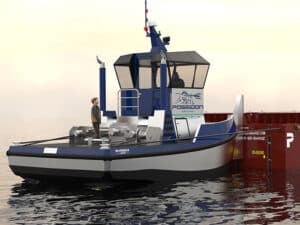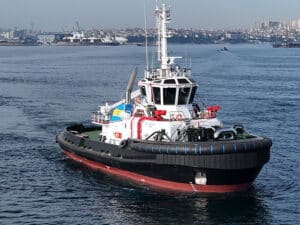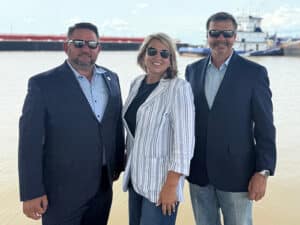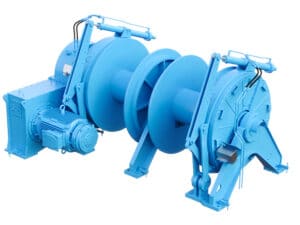
Q&A: Austal USA’s Larry Ryder talks shipbuilding hurdles, milestones and more
Written by Heather Ervin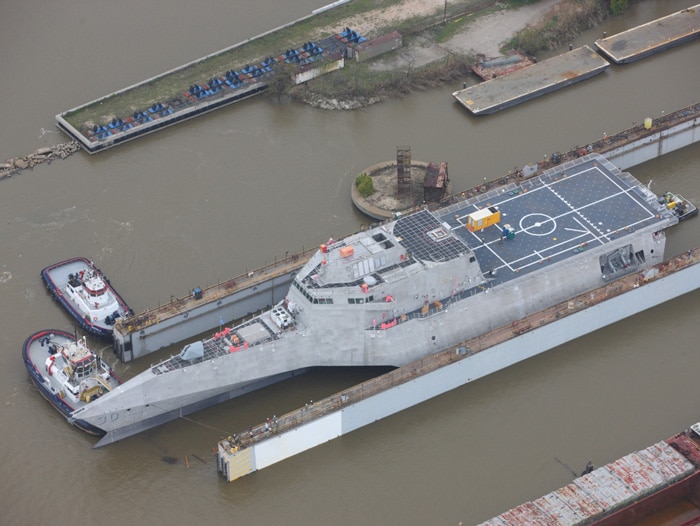
Aerial view of Austal USA shipyard dock, with tugs and the USS Canberra. (Credit: Austal USA)
As Marine Log gets its annual TTB 2022 (Tugs, Towboats & Barges) event underway next week, guests will have a unique opportunity to tour Austal USA in Mobile, Ala., one of the country’s premier military defense shipyards that specialize in the design, construction and support of military and commercial vessels.
In 2020, Austal USA purchased 15 acres of waterfront property on the west side of the Mobile River and established a ship service and maintenance facility. The Austal USA West Campus includes a 20,000-ton Panamax-class floating drydock and 100,000 square feet of covered repair facilities.
To find out more about the shipyard and what’s been going on there lately, we talked to Larry Ryder, vice president of business development and external affairs for Austal USA. Here’s what he had to say:
Marine Log (ML): As one of the country’s premier military defense shipyards that specializes in design, construction and support, Austal USA keeps busy with military ship contracts. What types of commercial vessels do you work on? Also, besides the U.S. Navy, who are your primary customers?

Larry Ryder (LR): In the past, we have focused primarily on ship construction and ship repair for the U.S. Navy. Our recent investment in three areas has allowed us to expand our base beyond the Navy.
First, we have added the capability to build steel ships in our Mobile shipyard that opens up other government and commercial opportunities. Second, we established a waterfront repair facility in San Diego that will include a dry dock to support government and commercial work. Finally, we have invested in establishing our Mobile repair facility to service government and commercial customers.
To date, we have supported customers of several different maritime sectors at our Mobile repair facility to include dredges, barges, ATBs, tugs, bulk freighters, and tankers just to name a few. The work has been a mixture of dry dock availabilities, as well as topside repairs accomplished pier side.
ML: What have been the biggest hurdles to shipbuilding over the last few years and how has Austal USA met those challenges?
LR: Shipbuilding is historically an industry that faces challenges. COVID was certainly a major challenge—we were able to sustain operations in all of our facilities throughout the pandemic due to our great workforce. The continued uncertainty and delays in the government budget and the Navy’s shipbuilding plan have also created issues we have had to work though over the last several years, especially with the 2022 budget process.
Despite the challenges we routinely face, we have continued to grow and evolve because of two factors.
First, we have a great workforce that build high-quality ships and provide quality repair services to our customers. Second, we have continued to invest in ourselves to meet the evolving needs of our customers. Our growth in our repair business and addition of steel shipbuilding are a couple recent examples of this commitment.
ML: Is there anything new coming online at the Mobile shipyard in 2022? Expansions, newbuilds, etc.?
LR: Austal USA has continued to invest in developing new capabilities to best meet the needs of our customer base now and in the future. We are going to continue to develop our steel shipbuilding facility and ship repair facility in Mobile. We have our first steel ships under contract from the Navy, and we are looking to grow our backlog with some wins on other programs.
We are developing our waterfront repair facility in San Diego and will be enhancing the site throughout 2022 to prepare for the arrival of our new build dry dock that will arrive in summer 2023. The other big change will be our continued growth in the western pacific to support ship repair operations, especially in Singapore and Guam.
Steel: Austal USA will begin production of steel ships for the first time in 2022 on our new state-of-the-art steel facility assembly line. The 117,000-square-foot manufacturing addition will house high-tech computerized and robotic steel processing equipment. The first ships built in the steel facility will be two Navajo-class Towing, Salvage & Rescue Ships (T-ATS) for the U.S. Navy.
Austal USA is also continuing making improvements to our west campus repair yard across the river from our main construction facility. The additional 15 acres of waterfront plus a floating dry dock is designed to support maintenance and repairs on both commercial and military ships while taking advantage of the engineering and state-of-the-art ship construction capabilities available at the main ship manufacturing facility. The dry dock also enables us to control the launch our new construction ships.
ML: Has Austal USA implemented any sustainable business practices into its shipbuilding and design processes? Has there been an increase in demand for these types of processes?
LR: Austal made a strategic decision to implement a full blown Lean Manufacturing methodology. When you walk through the Austal manufacturing facility, you can see similarities to other high-tech assembly lines such as a Toyota or Mercedes–Benz Lean automotive facility. Work stations are organized and clean and the scheduled work flows down a moving line. This long-term commitment to Lean is what sets Austal apart and is a key reason we have been able to deliver four ships per year.
To minimize waste and increase efficiencies, we use the latest technologies in ship manufacturing. These include, CNC machines, robotic welders, robotic cutters, massive cranes, and a friction stir station. These machines allow us to deliver material just in time which eliminates waste and increases production efficiency.
ML: Finally, what company milestones is Austal USA most proud of that our readers might find of interest?
LR: We are proud of how we have grown as part of the community in the Mobile region and developed a highly skilled workforce. We have a great team of shipbuilders that have enabled our success in delivering ships to the U.S. Navy on schedule and on budget.
We are also extremely proud of our team’s safety record we have earned 21 industry safety awards in the last 12 years, making us one of the safest shipyards in the country.

